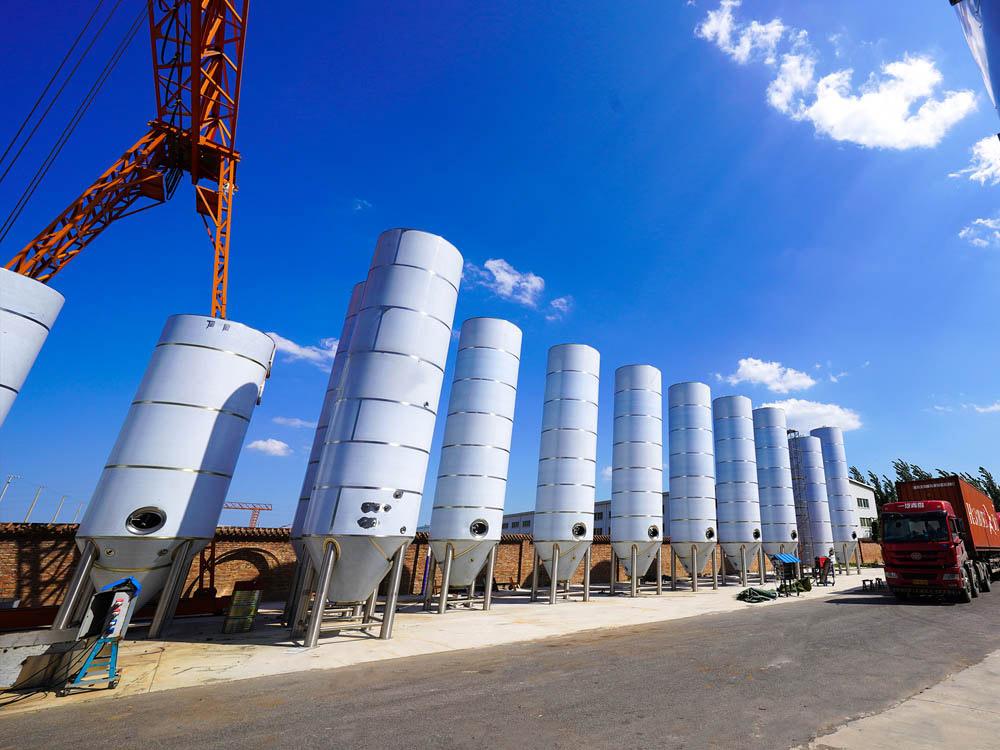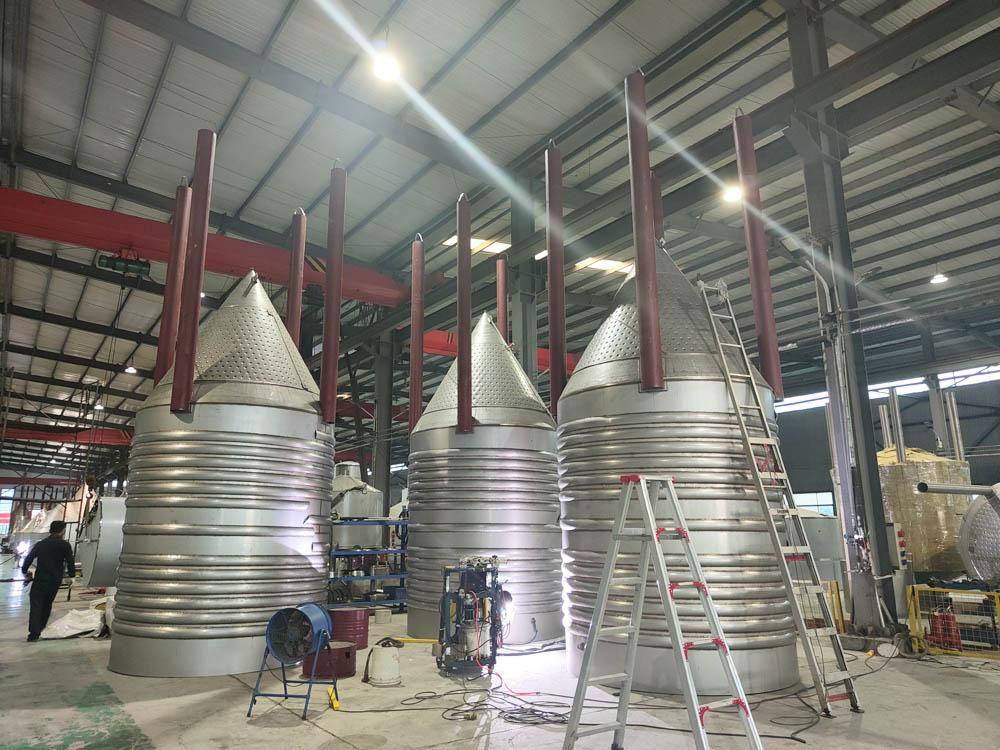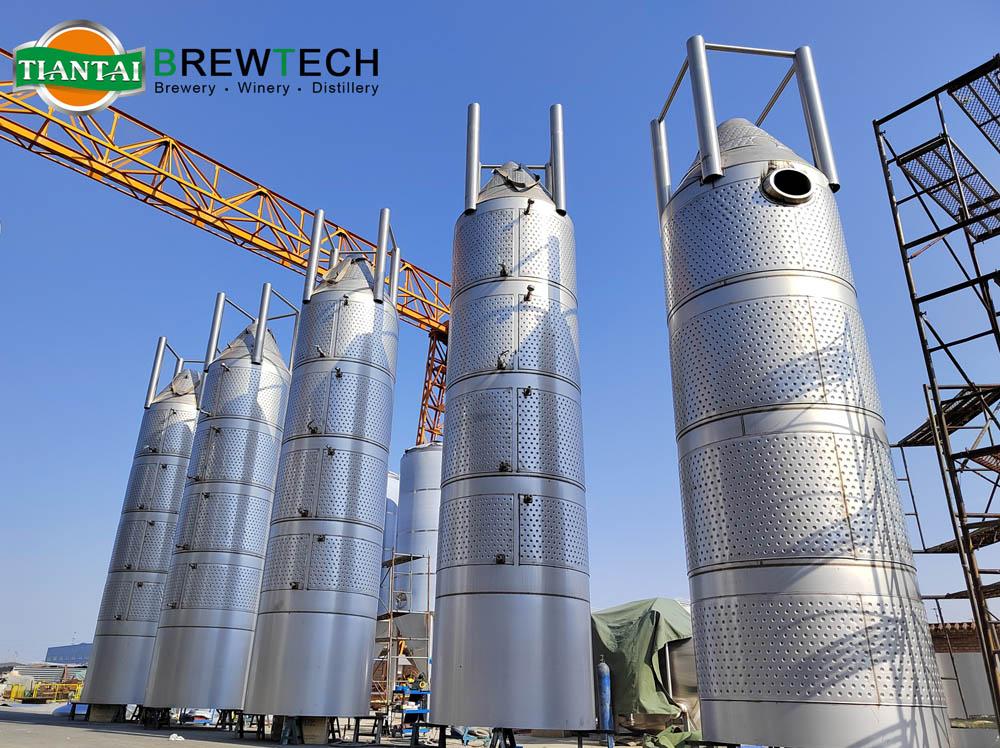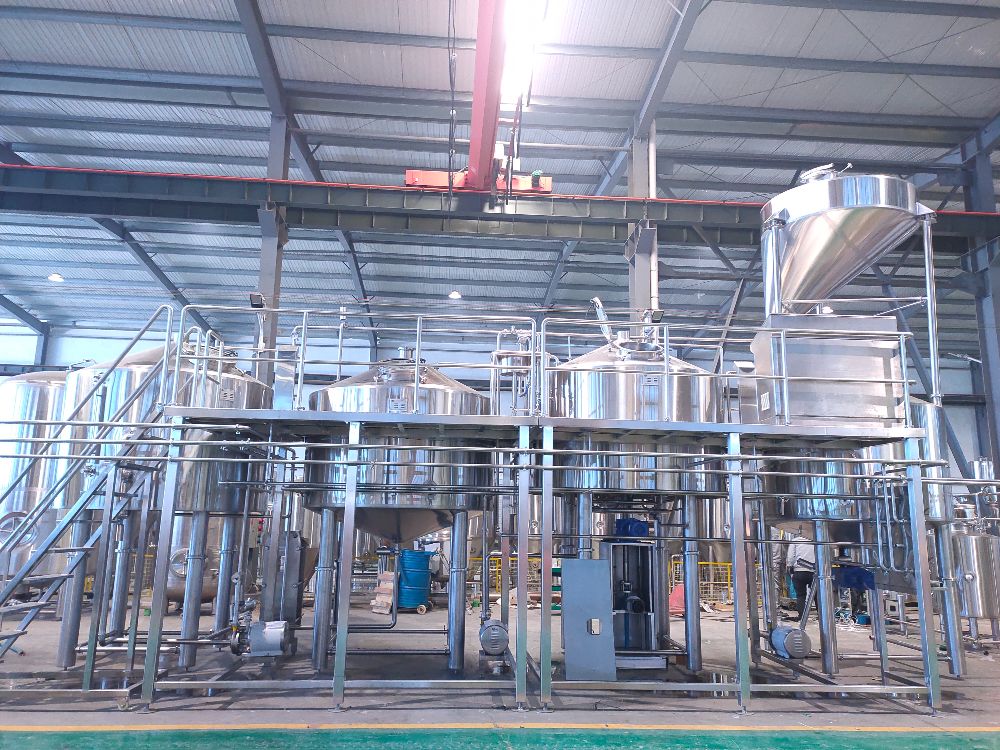Glycol Jacket Design of Beer Fermenter
- Sep 27, 2024
- 114
- tiantai
I.Why is Fermenter cooling so important in entire beer brewing process?
Fermenter cooling is essential throughout the brewing process, from controlling fermentation speed and yeast behavior to ensuring consistent flavor, preventing contamination, and enhancing productivity. Without effective cooling, beer quality would suffer, and the entire brewing process would become inefficient and unpredictable.
1. Regulates Fermentation Temperature
Yeast Performance: Fermentation is the most crucial stage where yeast converts sugars into alcohol and carbon dioxide. Yeast operates optimally within a specific temperature range (typically 10-20°C depending on beer style). Cooling ensures that the fermenter stays within this range.
Prevents Off-flavors: If the temperature gets too high, yeast produces unwanted by-products such as esters and fusel alcohols, which can cause off-flavors like fruity or solvent-like notes. Cooling helps prevent these issues.
2. Ensures Flavor Consistency
Stable Flavor Profiles: Controlling the fermentation temperature allows brewers to produce consistent batches of beer with uniform flavor profiles. Without proper cooling, fluctuating temperatures can lead to variability in taste and aroma between batches.
Controls Yeast Behavior: Different yeast strains have specific temperature ranges where they behave optimally. Cooling helps keep yeast in this ideal range, ensuring the intended beer style is achieved (e.g., lagers at low temperatures, ales at higher temperatures).
3. Manages Yeast Metabolism
Prevents Overactive Fermentation: Yeast generates heat during fermentation. Without proper cooling, the fermenter’s temperature can rise, leading to overly fast fermentation, which may stress the yeast and cause incomplete fermentation or undesirable flavors.
Improves Yeast Health: By maintaining a steady temperature, cooling also protects yeast from heat stress, improving yeast health and ensuring they ferment effectively.
4. Supports Various Brewing Techniques
Lagers vs. Ales: Different beer styles require different fermentation temperatures. Lagers ferment at colder temperatures (8-12°C), while ales ferment at warmer temperatures (15-20°C). Cooling systems allow for this precise control, enabling brewers to craft various styles.
Cold Crashing and Maturation: Cooling is essential during the final stages of fermentation, where the beer may be "cold crashed" (cooled to near-freezing temperatures) to clarify the beer and encourage particulates to settle.
5. Prevents Contamination
Inhibits Bacterial Growth: Higher temperatures can promote the growth of unwanted bacteria and microorganisms. Proper cooling lowers the risk of contamination by keeping the fermenter in a cooler environment, which is less favorable for harmful bacteria.
Protects Beer Quality: Keeping the beer at a controlled, low temperature ensures that the beer stays fresh, free from spoilage, and develops the intended taste characteristics.
6. Enhances Efficiency and Productivity
Shortens Production Time: Controlling the temperature accelerates the fermentation process by keeping the yeast active in its ideal environment. This helps maintain production schedules without compromising quality.
Improves Energy Efficiency: Properly designed fermenter cooling systems prevent overcooling and undercooling, saving energy and optimizing brewing costs.
7. Post-Fermentation Stabilization
Beer Conditioning: After primary fermentation, cooling is crucial during conditioning or maturation. Lower temperatures help the beer age properly, stabilize, and reach the desired clarity and flavor balance.
Packaging and Storage: Properly cooled beer is also more stable for packaging, ensuring that it remains fresh during transport and storage.
Conclusion

II.How to design glycol jacket of fermenter?
Designing a glycol jacket for a fermenter involves several key steps, each ensuring that the system efficiently controls the temperature of the fermentation process. Glycol jackets are used to circulate chilled glycol around the fermenter, cooling the beer inside.
1. Determine Fermenter Size and Shape
Capacity: First, you need to know the fermenter’s volume, which can range from small pilot tanks (50L) to large commercial fermenters (10,000L or more).
Shape: Fermenters are typically cylindrical with a conical bottom. The design should account for the cylindrical side walls and cone, as these areas will require different cooling solutions.
2. Understand Cooling Requirements
Heat Load Calculation: Calculate the amount of heat the glycol system needs to remove during fermentation. Factors include:
The initial temperature of the wort.
The desired fermentation temperature.
The heat produced by yeast during fermentation.
Ambient temperature.
Cooling Zones: Large fermenters often have multiple cooling zones. Typically, there are three zones:
Cone cooling at the bottom for yeast settling and sediment control.
Lower sidewall cooling where most of the liquid mass is stored.
Upper sidewall cooling, if required, for fine temperature adjustment. Smaller fermenters may have one or two zones.
3. Choose the Cooling Method
Dimpled Plate Jacket: Dimpled plates are welded to the outer wall of the fermenter. The dimpled pattern increases surface area, promoting better heat exchange between the glycol and the fermenter wall. They are commonly used on the conical bottom and can be used on the side walls as well.
Serpentine Coil Jacket: A serpentine coil consists of tubing that wraps around the fermenter. Glycol flows through the tubing, cooling the fermenter by direct contact. This is often used on the cylindrical portion of the fermenter to distribute cooling evenly.
Multi-Zone Glycol Jackets: For large fermenters, dividing the glycol jacket into multiple zones allows better control. Each zone can have independent glycol circulation to precisely control the cooling in specific areas.
4. Select the Jacket Material
Stainless Steel: The glycol jacket should be made from high-grade stainless steel (typically 304 or 316) for durability, corrosion resistance, and ease of cleaning. Stainless steel also ensures that the fermenter can withstand pressure and temperature variations.
Insulation: After the glycol jacket is installed, the fermenter should be insulated to prevent temperature losses to the environment. Insulation materials like polyurethane foam or fiberglass are commonly used.
5. Design the Flow Path
Flow Rate: Ensure the glycol flow rate is sufficient to remove the heat load calculated earlier. Too low a flow rate will reduce cooling efficiency, while too high a flow rate may lead to overcooling.
Inlet and Outlet Positioning: Position the glycol inlet and outlet in a way that allows efficient flow across the entire cooling surface. The glycol should enter at the lowest point and exit at the highest point of the jacket, ensuring maximum contact time.
Avoid Air Pockets: Ensure the glycol jacket’s design prevents air pockets, as these will reduce the system’s efficiency.
6. Control the Temperature
Glycol Temperature: The glycol solution is typically cooled to -2°C to 4°C (28°F to 39°F) depending on the fermentation requirements. The system should maintain this temperature to efficiently control the fermenter temperature.
Thermostatic Control: Use temperature sensors and a control system to monitor the temperature inside the fermenter. This system should activate the glycol pump as needed, ensuring precise temperature control throughout the fermentation process.
7. Pressure and Safety Considerations
Pressure Testing: Ensure the glycol jacket can withstand the operating pressures of the glycol system. The jacket needs to handle the flow of chilled glycol without leakage or deformation.
Pressure Relief Valve: Install pressure relief valves or expansion tanks to prevent excessive pressure buildup within the glycol system, which could damage the fermenter.
8. Testing and Optimization
Prototype Testing: Once the design is complete, test the prototype fermenter with glycol cooling in real conditions. Check for even temperature distribution across the fermenter, ensuring that no "hot spots" develop.
Optimization: Adjust the glycol flow rate, pressure, or the number of cooling zones based on initial test results to optimize cooling performance.
III.For Glycol jacket of big fermenter, why is it dimple plate on bottom and serpentine coil?
Dimple Plate on the Bottom:
Effective for heat transfer: The bottom of the fermenter, often called the cone or the bottom head, has a smaller surface area. Dimple plates, with their embossed dimples, maximize the contact area between the glycol and the fermenter’s surface, ensuring efficient heat transfer for cooling or heating.
Better structural integrity: Dimple plates provide a strong and stable surface, able to withstand high pressure and maintain the shape of the fermenter, especially in larger tanks.
Serpentine Coil on the Sides:
Improved heat distribution: Serpentine coils, which are continuous tubes running along the sides, allow glycol to flow in a more controlled manner, maintaining consistent cooling across the larger side walls of the fermenter.
More flexibility: Coils provide greater flexibility in directing the glycol flow to specific zones of the fermenter, which is important for maintaining uniform temperatures throughout the liquid.
This combination balances efficient heat transfer, structural strength, and flexibility in temperature control.

IV.For Glycol jacket of small fermenter, why is it full dimple plate on both cone bottom and side wall?
For small fermenters, a full dimple plate glycol jacket is often used because it provides efficient cooling, consistent temperature control, and cost-effectiveness.
1. Efficient Heat Transfer
Maximized Surface Area: Dimple plates are designed with small, indented patterns that increase the surface area in contact with the glycol. This enhances heat transfer between the glycol and the fermenter wall, allowing for quicker and more efficient cooling.
Uniform Cooling: The dimple pattern ensures that the glycol flows evenly across the entire surface of the fermenter, providing uniform cooling and avoiding "hot spots" inside the fermenter.
2. Compact and Space-Efficient
Full Coverage: Since small fermenters typically have less volume and surface area, a full dimple plate jacket can cover the entire surface of the tank. This provides consistent cooling throughout the tank without the need for complex multi-zone designs often required for larger fermenters.
No Need for Multiple Zones: In small fermenters, there’s no need to break the cooling system into separate zones (cone, sidewall, etc.) because the volume of liquid is smaller. A full dimple plate jacket offers efficient temperature control across the entire surface, simplifying the design.
3. Cost-Effective for Small Tanks
Lower Material and Installation Costs: A full dimple plate jacket is often more cost-effective for small fermenters because it simplifies the design and requires less material than installing serpentine coils or separate cooling zones. For smaller vessels, a single, full-coverage dimple plate jacket is sufficient to handle cooling needs.
Simpler Production and Maintenance: The straightforward design of a full dimple plate reduces complexity during manufacturing and makes it easier to maintain and clean.
4. Durability and Longevity
Stainless Steel Construction: Dimple plates are typically made from stainless steel, which provides excellent durability and corrosion resistance. This makes them well-suited for long-term use in brewing environments where sanitation and durability are critical.
Withstands Pressure: The dimpled pattern helps distribute pressure evenly across the fermenter wall, preventing damage or deformation over time, especially when glycol circulates under pressure.
5. Easy Integration with Cooling Systems
Simplified Glycol Flow: The dimple plate allows for smooth glycol flow without the need for complex piping. This makes it easier to integrate the fermenter into the overall glycol cooling system and reduces the chances of blockages or inefficient flow.
Consistent Performance: For small fermenters, the consistent flow of glycol over a full dimple plate ensures that the beer inside stays within the desired fermentation temperature range, leading to more predictable and consistent results.

Tiantai Brewtech has helped 2600+ breweries to design and manufacture their fermenter in 96+ countries. We has rich experience and professional data to design suitable glycol jacket from 50L-50000L Fermenter. If you are looking for fermenter or you are planning to build a brewery, do not hesitate to contact us please. Consultation and Drawing are FREE OF CHARGE. Look forward to discussing together with you.
Edited by Vicky
Sales director in Tiantai Brewtech
Email: [email protected]
Fermenter cooling is essential throughout the brewing process, from controlling fermentation speed and yeast behavior to ensuring consistent flavor, preventing contamination, and enhancing productivity. Without effective cooling, beer quality would suffer, and the entire brewing process would become inefficient and unpredictable.
1. Regulates Fermentation Temperature
Yeast Performance: Fermentation is the most crucial stage where yeast converts sugars into alcohol and carbon dioxide. Yeast operates optimally within a specific temperature range (typically 10-20°C depending on beer style). Cooling ensures that the fermenter stays within this range.
Prevents Off-flavors: If the temperature gets too high, yeast produces unwanted by-products such as esters and fusel alcohols, which can cause off-flavors like fruity or solvent-like notes. Cooling helps prevent these issues.
2. Ensures Flavor Consistency
Stable Flavor Profiles: Controlling the fermentation temperature allows brewers to produce consistent batches of beer with uniform flavor profiles. Without proper cooling, fluctuating temperatures can lead to variability in taste and aroma between batches.
Controls Yeast Behavior: Different yeast strains have specific temperature ranges where they behave optimally. Cooling helps keep yeast in this ideal range, ensuring the intended beer style is achieved (e.g., lagers at low temperatures, ales at higher temperatures).
3. Manages Yeast Metabolism
Prevents Overactive Fermentation: Yeast generates heat during fermentation. Without proper cooling, the fermenter’s temperature can rise, leading to overly fast fermentation, which may stress the yeast and cause incomplete fermentation or undesirable flavors.
Improves Yeast Health: By maintaining a steady temperature, cooling also protects yeast from heat stress, improving yeast health and ensuring they ferment effectively.
4. Supports Various Brewing Techniques
Lagers vs. Ales: Different beer styles require different fermentation temperatures. Lagers ferment at colder temperatures (8-12°C), while ales ferment at warmer temperatures (15-20°C). Cooling systems allow for this precise control, enabling brewers to craft various styles.
Cold Crashing and Maturation: Cooling is essential during the final stages of fermentation, where the beer may be "cold crashed" (cooled to near-freezing temperatures) to clarify the beer and encourage particulates to settle.
5. Prevents Contamination
Inhibits Bacterial Growth: Higher temperatures can promote the growth of unwanted bacteria and microorganisms. Proper cooling lowers the risk of contamination by keeping the fermenter in a cooler environment, which is less favorable for harmful bacteria.
Protects Beer Quality: Keeping the beer at a controlled, low temperature ensures that the beer stays fresh, free from spoilage, and develops the intended taste characteristics.
6. Enhances Efficiency and Productivity
Shortens Production Time: Controlling the temperature accelerates the fermentation process by keeping the yeast active in its ideal environment. This helps maintain production schedules without compromising quality.
Improves Energy Efficiency: Properly designed fermenter cooling systems prevent overcooling and undercooling, saving energy and optimizing brewing costs.
7. Post-Fermentation Stabilization
Beer Conditioning: After primary fermentation, cooling is crucial during conditioning or maturation. Lower temperatures help the beer age properly, stabilize, and reach the desired clarity and flavor balance.
Packaging and Storage: Properly cooled beer is also more stable for packaging, ensuring that it remains fresh during transport and storage.
Conclusion

II.How to design glycol jacket of fermenter?
Designing a glycol jacket for a fermenter involves several key steps, each ensuring that the system efficiently controls the temperature of the fermentation process. Glycol jackets are used to circulate chilled glycol around the fermenter, cooling the beer inside.
1. Determine Fermenter Size and Shape
Capacity: First, you need to know the fermenter’s volume, which can range from small pilot tanks (50L) to large commercial fermenters (10,000L or more).
Shape: Fermenters are typically cylindrical with a conical bottom. The design should account for the cylindrical side walls and cone, as these areas will require different cooling solutions.
2. Understand Cooling Requirements
Heat Load Calculation: Calculate the amount of heat the glycol system needs to remove during fermentation. Factors include:
The initial temperature of the wort.
The desired fermentation temperature.
The heat produced by yeast during fermentation.
Ambient temperature.
Cooling Zones: Large fermenters often have multiple cooling zones. Typically, there are three zones:
Cone cooling at the bottom for yeast settling and sediment control.
Lower sidewall cooling where most of the liquid mass is stored.
Upper sidewall cooling, if required, for fine temperature adjustment. Smaller fermenters may have one or two zones.
3. Choose the Cooling Method
Dimpled Plate Jacket: Dimpled plates are welded to the outer wall of the fermenter. The dimpled pattern increases surface area, promoting better heat exchange between the glycol and the fermenter wall. They are commonly used on the conical bottom and can be used on the side walls as well.
Serpentine Coil Jacket: A serpentine coil consists of tubing that wraps around the fermenter. Glycol flows through the tubing, cooling the fermenter by direct contact. This is often used on the cylindrical portion of the fermenter to distribute cooling evenly.
Multi-Zone Glycol Jackets: For large fermenters, dividing the glycol jacket into multiple zones allows better control. Each zone can have independent glycol circulation to precisely control the cooling in specific areas.
4. Select the Jacket Material
Stainless Steel: The glycol jacket should be made from high-grade stainless steel (typically 304 or 316) for durability, corrosion resistance, and ease of cleaning. Stainless steel also ensures that the fermenter can withstand pressure and temperature variations.
Insulation: After the glycol jacket is installed, the fermenter should be insulated to prevent temperature losses to the environment. Insulation materials like polyurethane foam or fiberglass are commonly used.
5. Design the Flow Path
Flow Rate: Ensure the glycol flow rate is sufficient to remove the heat load calculated earlier. Too low a flow rate will reduce cooling efficiency, while too high a flow rate may lead to overcooling.
Inlet and Outlet Positioning: Position the glycol inlet and outlet in a way that allows efficient flow across the entire cooling surface. The glycol should enter at the lowest point and exit at the highest point of the jacket, ensuring maximum contact time.
Avoid Air Pockets: Ensure the glycol jacket’s design prevents air pockets, as these will reduce the system’s efficiency.
6. Control the Temperature
Glycol Temperature: The glycol solution is typically cooled to -2°C to 4°C (28°F to 39°F) depending on the fermentation requirements. The system should maintain this temperature to efficiently control the fermenter temperature.
Thermostatic Control: Use temperature sensors and a control system to monitor the temperature inside the fermenter. This system should activate the glycol pump as needed, ensuring precise temperature control throughout the fermentation process.
7. Pressure and Safety Considerations
Pressure Testing: Ensure the glycol jacket can withstand the operating pressures of the glycol system. The jacket needs to handle the flow of chilled glycol without leakage or deformation.
Pressure Relief Valve: Install pressure relief valves or expansion tanks to prevent excessive pressure buildup within the glycol system, which could damage the fermenter.
8. Testing and Optimization
Prototype Testing: Once the design is complete, test the prototype fermenter with glycol cooling in real conditions. Check for even temperature distribution across the fermenter, ensuring that no "hot spots" develop.
Optimization: Adjust the glycol flow rate, pressure, or the number of cooling zones based on initial test results to optimize cooling performance.
III.For Glycol jacket of big fermenter, why is it dimple plate on bottom and serpentine coil?
Dimple Plate on the Bottom:
Effective for heat transfer: The bottom of the fermenter, often called the cone or the bottom head, has a smaller surface area. Dimple plates, with their embossed dimples, maximize the contact area between the glycol and the fermenter’s surface, ensuring efficient heat transfer for cooling or heating.
Better structural integrity: Dimple plates provide a strong and stable surface, able to withstand high pressure and maintain the shape of the fermenter, especially in larger tanks.
Serpentine Coil on the Sides:
Improved heat distribution: Serpentine coils, which are continuous tubes running along the sides, allow glycol to flow in a more controlled manner, maintaining consistent cooling across the larger side walls of the fermenter.
More flexibility: Coils provide greater flexibility in directing the glycol flow to specific zones of the fermenter, which is important for maintaining uniform temperatures throughout the liquid.
This combination balances efficient heat transfer, structural strength, and flexibility in temperature control.

IV.For Glycol jacket of small fermenter, why is it full dimple plate on both cone bottom and side wall?
For small fermenters, a full dimple plate glycol jacket is often used because it provides efficient cooling, consistent temperature control, and cost-effectiveness.
1. Efficient Heat Transfer
Maximized Surface Area: Dimple plates are designed with small, indented patterns that increase the surface area in contact with the glycol. This enhances heat transfer between the glycol and the fermenter wall, allowing for quicker and more efficient cooling.
Uniform Cooling: The dimple pattern ensures that the glycol flows evenly across the entire surface of the fermenter, providing uniform cooling and avoiding "hot spots" inside the fermenter.
2. Compact and Space-Efficient
Full Coverage: Since small fermenters typically have less volume and surface area, a full dimple plate jacket can cover the entire surface of the tank. This provides consistent cooling throughout the tank without the need for complex multi-zone designs often required for larger fermenters.
No Need for Multiple Zones: In small fermenters, there’s no need to break the cooling system into separate zones (cone, sidewall, etc.) because the volume of liquid is smaller. A full dimple plate jacket offers efficient temperature control across the entire surface, simplifying the design.
3. Cost-Effective for Small Tanks
Lower Material and Installation Costs: A full dimple plate jacket is often more cost-effective for small fermenters because it simplifies the design and requires less material than installing serpentine coils or separate cooling zones. For smaller vessels, a single, full-coverage dimple plate jacket is sufficient to handle cooling needs.
Simpler Production and Maintenance: The straightforward design of a full dimple plate reduces complexity during manufacturing and makes it easier to maintain and clean.
4. Durability and Longevity
Stainless Steel Construction: Dimple plates are typically made from stainless steel, which provides excellent durability and corrosion resistance. This makes them well-suited for long-term use in brewing environments where sanitation and durability are critical.
Withstands Pressure: The dimpled pattern helps distribute pressure evenly across the fermenter wall, preventing damage or deformation over time, especially when glycol circulates under pressure.
5. Easy Integration with Cooling Systems
Simplified Glycol Flow: The dimple plate allows for smooth glycol flow without the need for complex piping. This makes it easier to integrate the fermenter into the overall glycol cooling system and reduces the chances of blockages or inefficient flow.
Consistent Performance: For small fermenters, the consistent flow of glycol over a full dimple plate ensures that the beer inside stays within the desired fermentation temperature range, leading to more predictable and consistent results.

Tiantai Brewtech has helped 2600+ breweries to design and manufacture their fermenter in 96+ countries. We has rich experience and professional data to design suitable glycol jacket from 50L-50000L Fermenter. If you are looking for fermenter or you are planning to build a brewery, do not hesitate to contact us please. Consultation and Drawing are FREE OF CHARGE. Look forward to discussing together with you.
Edited by Vicky
Sales director in Tiantai Brewtech
Email: [email protected]



.jpg)
